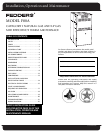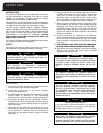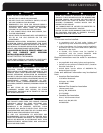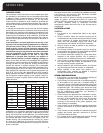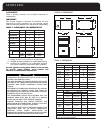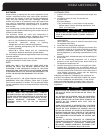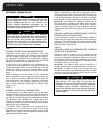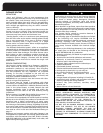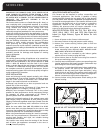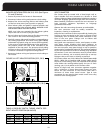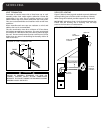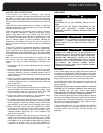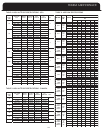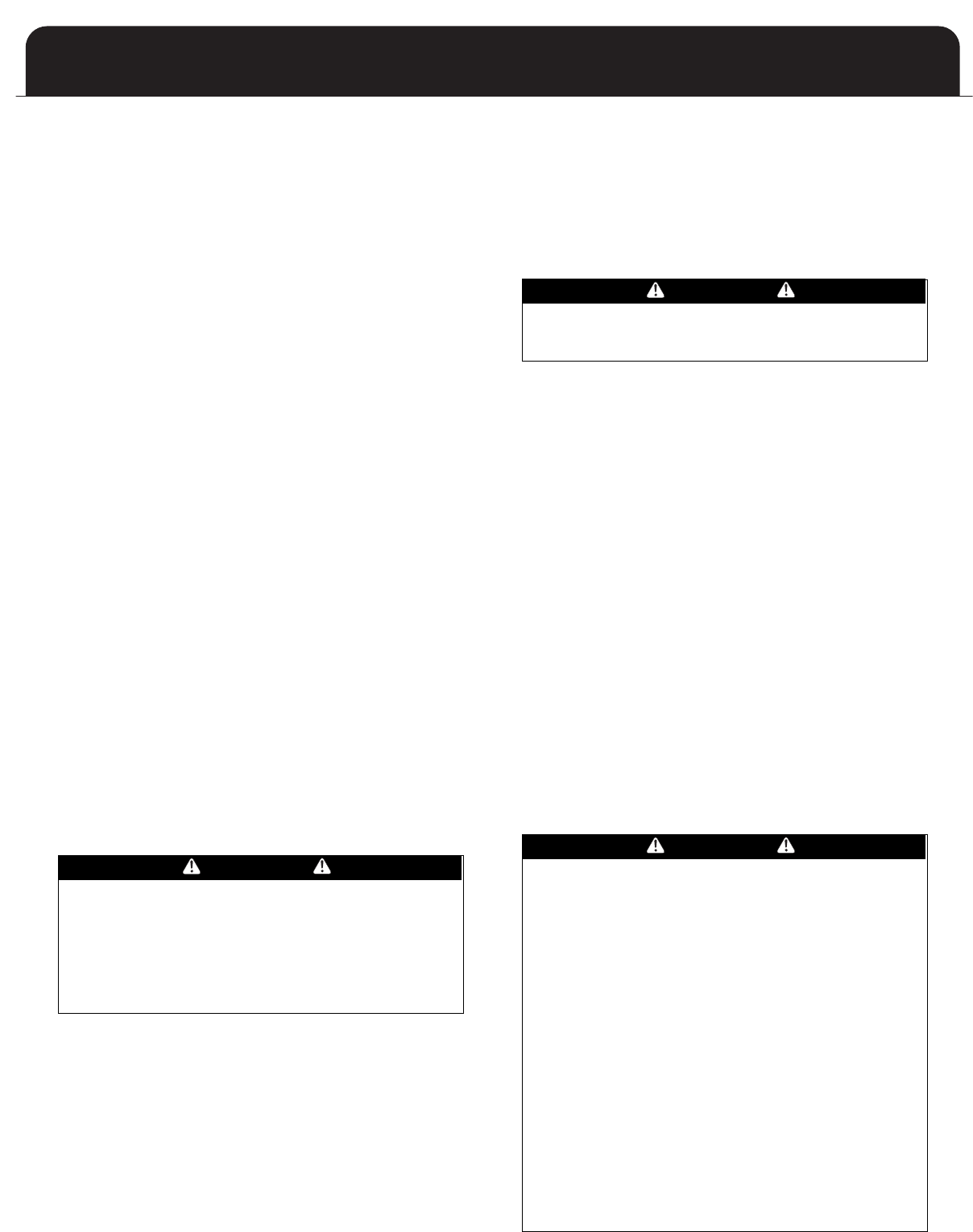
6
WARM AIR FURNACE
D
UCTWORK STEPS:
1
. Position the furnace to minimize ductwork length and
fittings.
2
. Cut open a return air inlet. The choices are:
a) either side
b) furnace bottom
c
) any combination, i.e. two sides or a side and the
bottom. Note: 2 return openings required for 70-4,
100-5, 115-5 and 135-5.
D
UCTWORK
Proper airflow is required for the correct operation of this
f
urnace. Insufficient airflow may cause erratic operation,
could cause the furnace to cycle on the high temperature
limit, and may damage the heat exchanger. Excessive
airflow may result in an excessively noisy duct system and
may result in undesirable consequences such as creating
u
ncomfortable drafts and causing drapes or curtains to
blow around.
If air conditioning is to be used with the furnace, the duct
s
ystem must be capable of delivering the correct amount of
airflow for each system.
The ductwork should be sized and constructed in
accordance with accepted industry standards. Duct sizing
and construction information may be obtained from:
• A.C.C.A. (Air Conditioning Contractors of America)
• A.S.H.R.A.E. (American Society of Heating,
Refrigeration and Air Conditioning Engineers)
• H.R.A.I. (Heating, Refrigerating and Air Conditioning
Institute (Canada)
• S.M.A.C.N.A. (Sheet Metal and Air Conditioning
Contractors’ National Association (United States)
All of the above professional organizations have duct sizing
manuals available.
The total static pressure drop of the air distribution system
should not exceed 0.5 inches water column.
NOTE:
UNITS 70-4, 100-5, 115-5 AND 135-5 MUST HAVE DUAL
RETURN AIR INLETS FOR OPTIMAL AIRFLOW AND AIR
FILTRATION. IF NOT SPECIFICALLY STATED BY THE FILTER
MANUFACTURER, FOR EFFECTIVE AIR FILTRATION, ASSUME
A MAXIMUM VELOCITY OF 300 FPM FOR DISPOSABLE TYPE
FILTERS, OR 600 FPM FOR PERMANENT TYPE FILTERS.
GUIDE:
Filter free area (in
2
) = 144 x (CFM / desired velocity (fpm))
IMPORTANT: Some high efficiency filters have a greater
than normal resistance to airflow. This can adversely affect
furnace operation. Ensure to check the airflow when using
any filter.
W
ARNING
DO NOT, UNDER ANY CIRCUMSTANCES, CONNECT
RETURN OR SUPPL
Y AIR DUCTWORK TO OR FROM ANY
OTHER HEA
T
-PRODUCING DEVICE SUCH AS A FIREPLACE
INSERT, STOVE, ETC. DOING SO MAY RESULT IN FIRE,
CARBON MONOXIDE POISONING, EXPLOSION,
PERSONAL INJURY, LOSS OF LIFE, OR PROPERTY
DAMAGE.
CAUTION
D
O NOT USE THE REAR PANEL AS A RETURN AIR INLET.
THERE IS INSUFFICIENT ROOM TO PERMIT ADEQUATE
AIRFLOW.
WARNING
NEVER ALLOW THE PRODUCTS OF COMBUSTION FROM
THE FLUE TO ENTER THE RETURN AIR OR SUPPLY AIR
DUCTWORK.
ALL RETURN AIR DUCTWORK MUST BE ADEQUA
TELY
SEALED AND SECURED TO THE FURNACE WITH SHEET
METAL SCREWS. TAPE THE SHEET METAL SEAMS IN THE
VICINITY OF THE FURNACE WITH DUCT TAPE OR
SIMILAR MA
TERIAL.
WHEN THE FURNACE IS MOUNTED ON A PLATFORM
WITH RETURN AIR THROUGH THE BOTTOM, IT MUST BE
SEALED AIR TIGHT BETWEEN THE FURNACE AND THE
RETURN AIR PLENUM. THE FLOOR OR PLA
TFORM MUST
PROVIDE SOUND PHYSICAL SUPPORT OF THE FURNACE
WITHOUT SAGGING, CRACKS OR GAPS AROUND THE
BASE, PROVIDING A SEAL BETWEEN THE SUPPORT AND
THE BASE.
F
AILURE TO PREVENT PRODUCTS OF COMBUSTION
FROM BEING CIRCULATED INTO THE LIVING SPACE CAN
CREATE POTENTIALLY HAZARDOUS CONDITIONS,
INCLUDING CARBON MONOXIDE POISONING THA
T
COULD RESULT IN PERSONAL INJURY OR DEATH.
In all cases, cut the inlet air opening the full width of
the knockouts.
NOTE: When two return air inlets are used, both must
be equipped with filters.
3. Install the filter rack(s) (field supplied).
4. Connect the return air duct or fitting to the furnace. The
connection should be as air tight as possible to prevent
entraining combustion gases from an adjacent fuel
burning appliance, or entraining combustion air for this
furnace .
5. Ensure that there is adequate space and accessibility for
the air filter.
6. If an air conditioning evaporator coil is required,
position it on the top of the furnace. Ensure that no air
can bypass the evaporator coil.
7. Connect the supply air plenum to the supply air outlet.
Flexible duct connectors are an effective device to
prevent the telegraphing of mechanical noise from the
furnace to other parts of the home via the ductwork. If
using flexible connectors, ensure that the adjoining
duct is independently supported.
Adequate provisions for combustion and ventilation air
must be in accordance with ANSI Z223.1 (NFPA 54), section
5.3 "Air for Combustion and Ventilation" in the United
States, and CAN/CGA B149 in Canada. Check with local
authorities for any additional building codes, bylaws or
regulations.



